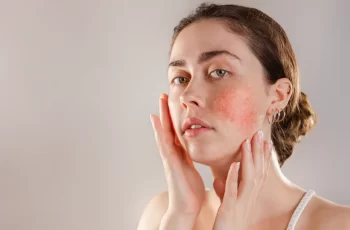
Can I use a salicylic acid serum after LED treatment?
LED, also known as red light therapy, is currently on the rise, especially now that easy-to-use devices are available for home use, and everyone can benefit from intense and impressive results. Since LED therapy helps heal wounds, repair tissue, and fight inflammation, is it a good idea to use salicylic acid at the same time as the treatment? Or can the combination achieve incredible skin results?
Well, let’s learn more and explore whether you can use a salicylic acid serum after LED treatment.
Can I use salicylic acid with light therapy?
Yes, believe it or not! Salicylic acid and other beta-hydroxy acids (BHAs) are oil-soluble and can penetrate deep into the lower layers of the skin. They can target clogged pores and clear the buildup of excess sebum, bacteria, dirt, debris, and other impurities. They also have anti-inflammatory properties that can break down the binding of dead skin cells to the skin’s surface. Combining salicylic acid or BHA with light therapy can be effective in fighting breakouts. Some people often find that salicylic acid is too strong for their skin, especially for dry and sensitive skin types. Therefore, LED is the top choice for effectively treating skin imperfections without the drying effects of salicylic acid.
Can you use LED light after a chemical peel?
You certainly can, as many reputable salons actually offer the use of LED light after a chemical peel. The combination of the two is thought to result in a radiant, fresh complexion with little to no downtime.
Originally an idea from NASA and the Navy SEALs, LED light therapy uses blue and red light to promote muscle growth and allow wounds on the surface of the skin to heal quickly. Since this method is completely painless and works so well, it was only a matter of time before the beauty industry took a liking to the idea, resulting in LED treatment devices being everywhere.
LED light therapy is an effective and non-invasive way to fight the signs of aging by stimulating the production of collagen and elastin, both of which play an important role in giving your skin a plump, hydrated appearance and youthful glow.
Although it sounds complicated, combining LED light therapy with a chemical peel is a safe and effective way to address the most common skin concerns, from early signs of aging like hyperpigmentation, dark spots, fine lines and wrinkles, to loss of skin elasticity.
Can I use LED lights with retinol?
Yes, believe it or not, you can use LED lights with retinol. I completely understand that this can be a little daunting due to retinol’s reputation for being very effective for the skin. Although retinol comes with a set of instructions on how to introduce it into your daily routine and build skin tolerance, it is recommended to apply the retinol to the skin after using the LED light to minimize irritation or increased skin sensitivity.
For best results, wait until after your evening skincare routine is complete before doing your LED treatment session. Afterwards, wait about 10 minutes before applying your retinol product, then go to bed and let the vitamin A work its magic while you catch up on your beauty sleep.
I know it sounds simple, but it’s important to consult a doctor, dermatologist, or trained professional before trying any new formula or ingredient on your skin to avoid unnecessary irritation.
How often should you use red light therapy on your face?
This largely depends on the skin concern you want to treat, from combating uneven skin tone to minimizing the appearance of fine lines and wrinkles to healing long-term sun damage. It is recommended to perform 3-5 sessions per week for about 10-20 minutes each for 4 months for best results and visible changes in your skin tone. There are a variety of advantages to using LED therapy, including the red light in the machine. Here are some of the main benefits you can expect:
Anti-aging – Red light can stimulate skin cells (also known as fibroblasts) and boost the production of collagen in the skin. It can help the skin repair damage and reduce the appearance of wrinkles and fine lines on the skin. Over time, you will notice that your complexion looks smoother and tighter.
Wound healing – As mentioned above, red light helps stimulate the skin’s collagen. This is very effective for superficial wounds on the skin, and many studies have shown that signs of redness are reduced, swelling and inflammation subside, and bruises heal quickly.
You will find that the combination of red and blue light creates a powerful skin combination that can address a range of skin issues. Especially when there are signs of inflammation and redness.
Do LED lights help with acne scars?
Yes, they absolutely do! Acne scars occur when blemishes are squeezed or broken, causing a break in the surface of the skin. This small wound can develop into a dark spot, which only becomes more pigmented when exposed to the sun. Fortunately, LED light therapy allows you to repair sun damage with regular treatments and daily use of an SPF 30 or higher sunscreen. Other acne scars, such as those that make your face uneven in texture, can also be alleviated through collagen stimulation, resulting in a smoother, more even, and more radiant complexion.
Here are some tips for using salicylic acid serums with LED therapy, as well as more details on the benefits you’ll experience when using LED therapy. Don’t forget to follow us on Instagram, where you can find me if you have any questions or just want to discuss skin issues!
DQH Can I use salicylic acid first and then vitamin C?
It’s easy to create a skincare routine, but knowing how to use it is another thing entirely. In most cases, if you’re not getting the desired skin results, it could be due to the layering of conflicting ingredients. So, is it possible that salicylic acid and vitamin C are such ingredients? Or are these active ingredients the duo that’s been missing from your skincare routine? If you want answers, stick around because today we are going to explain the benefits of salicylic acid and vitamin C and how they can be used in your daily life.
What are the benefits of salicylic acid for skin?
Salicylic acid is one of the most commonly used beta hydroxy acids and is favored by many people with oily, acne-prone skin. This acid is derived from willow bark, and unlike its water-soluble relatives (called alpha-hydroxy acids), salicylic acid is oil-soluble, which means it can penetrate deeper into the lower layers of the skin. Once it reaches the lower layers, it can help unclog pores of excess sebum, dirt, bacteria, debris, and impurities. This results in clearer skin tones and greater definition.
Not only does salicylic acid benefit the underlying layers, but the outer surface of the skin benefits as well. When applied to the skin, salicylic acid removes the buildup of dead skin cells. This is accomplished by breaking the bonds that hold dead cells to the surface. Over time, this can cause the complexion to look dull and prone to acne, blackheads, and other blemishes.
If you’d like to learn more about salicylic acid and how it can improve your skin, check out this dedicated blog post from a beauty insider.
What are the benefits of vitamin C for skin?
Vitamin C is considered one of the most powerful antioxidants, which means it is very effective at fighting free radicals and preventing them from causing further skin damage. Examples of free radicals include pollution, central heating, UV rays and harsh climate. They attack proteins, fats and cell membranes as soon as they come into contact with the skin, causing signs of premature aging such as fine lines and wrinkles as well as hyperpigmentation, flaky patches of skin and loss of elasticity.
Many people usually prefer to use vitamin C in their morning routine as this ingredient gives the complexion a radiant glow. You’ll also find that vitamin C can target areas of hyperpigmentation, plumping the skin and reducing the appearance of fine lines and wrinkles.
The thing about vitamin C is that there are a lot of outdated studies going back to the 1950s that describe vitamin C as an unstable skin component. Thanks to improvements in modern technology, this is no longer the case as all products now contain a stable form of vitamin C.
Visit The Beauty Insider to learn more about vitamin C. So please check out our blog post.
Can I use salicylic acid first and then vitamin C?
Yes, you absolutely can. In fact, it’s thought that using salicylic acid before using vitamin C ensures it penetrates faster and works faster.
This is an efficient way to utilize two power sources, and the reason has to do with pH. For example, the skin’s natural pH is about 4.7, making it slightly acidic. Salicylic acid and vitamin C are also both acidic, and you’ll find that vitamin C is absorbed quickly into the skin. Therefore, using salicylic acid beforehand can increase the acidity of the skin and allow vitamin C to penetrate into the skin faster.
While this is considered an effective way to combine two powerful ingredients, you need to be aware of your skin type and how it reacts to certain active ingredients. Even people with perfect, normal skin can experience skin sensitivity and irritation. Therefore, always consult a doctor or dermatologist before using any new products on your skin.
It’s also important to follow skin application rules. In this case, you need to use the product correctly to ensure you get the best results for your skin. If you’re not sure what I mean, the basic rule for skin is to start with the thinnest consistency and work your way up to the thickest consistency. This prevents a barrier from forming on the surface, preventing other active ingredients from penetrating the skin.
Can I use salicylic acid at night and vitamin C in the morning?
Yes, absolutely, this is considered the most effective way to get returns without any adverse side effects. This is because there is enough time between applications to ensure that the skin’s pH levels return to balance.
You’ll also find that Vitamin C is rich in antioxidants and is perfect for use in the morning to ensure your skin is protected and looking its healthiest. Due to the small size of salicylic acid molecules, it is an acid that is able to reach the deepest parts of the skin. While this is effective at keeping skin clear, it also increases the risk of irritation and photosensitivity. Therefore, many people prefer to use powerful BHAs in their evening routine without exposure to UV rays, pollution, or harsh weather.
Warning: If you avoid using sunscreen every day, none of these ingredients will do what your skin needs. The combination of chemical peels and powerful ingredients increases the risk of further damage to the skin’s surface. Use SPF 50 every day to keep your skin protected and your lipid barrier healthy, even on cloudy days, keeping your skin in top condition.


